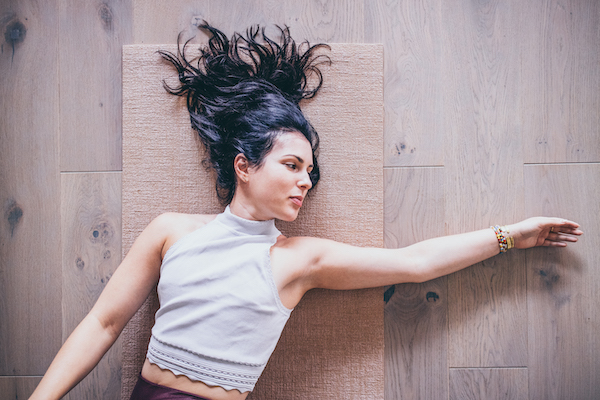Yoga is for every body and everybody
by Jordan Ashley | June 12, 2020 7:48 pm
“Yoga is for every body and everybody, ” my teacher Ali Cramer says to our packed and attentive yoga class in New York City. ” I look around the room and see so many faces and bodies comprised of different shapes, ages, sizes, colors, and genders. How incredible to have so many individuals gathered together to have the experience of collective movement.
While big cities will always be culinations of diversity, be it on the train or in the gym, this inclusive mentality has unfortunately gotten left behind in the current projection of the “wellness world. ” White, female, heterosexual, skinny, elitist, doing a handstand against a remote and luxurious beachside setting has become the tragic status quo for representing mainstream yoga. While brands are slowly becoming more body positive and woke in an attempt to equalize the representation of yogis from different walks of life, it’s easy to feel turned off and disenchanted by yoga.

“I don’t look like that. ” “I’m not flexible. ” “Isn’t it just stretching? ” “Don’t mostly women do yoga? ” Or all common inquiries and misconceptions that I have heard countless times. Just like Ali said, “Yoga is for everybody and every body, ” being that it is an adaptive practice based on the individual. Yoga means “union ” this idea of uniting the body, mind, and breath for mindful and conscious movement. Anyone can appreciate that be it a boxer or a figure skater. It’s about creating balance, finding equanimity not just when you are sweating it out on the spin bike but during your day-to-day life when you leave the mat or treadmill in hopes of feeling a little more centered or grounded. Just like someone who is weight training would have a schedule for arm days versus leg days, the same philosophy of balance applies and weaving yoga into your workout ritual is a great place to gain external support. For as many active and sweat inducing workout classes you do, try to find the time to carve out restorative or calming practices to find more introspective. Example: if you take a HIIT class on a Wednesday take a yin yoga class on a Sunday.
Yoga is all about repetition, hence why it’s called a “practice. ” There is no end goal. It’s about how you show up everytime and cultivate compassion around the present. When we are guided to repeat the same shapes, poses, and essentially the ritual of mindful movement, things begin to shift from the mat into our daily lives. The physical practice of yoga, or asana, encourages us to challenge our physical limitations or find our edge and breathe through the discomfort, awkwardness, or even fear (such as inversions or arm balances).
It’s a humbling practice as we are asked to try movements or breathing techniques, even meditating which can be jarring. So much of our existence is about distraction be it work, family obligations, binge watching tv shows, or even romantic relationships. While all of these are intrinsic to our modern existence, what yoga does is ask us to shift our priorities. Is this friendship serving me? Is my chosen career path fulfilling me? Questions that usually we might dismiss come up, and it’s through this quest, this curiosity of examining our deeper truths versus our perceived reality, that we begin to make choices from a grounded and heartfelt place.
Some teachers believe that the poses that are most challenging, be it physically or mentally, are the ones we should be doing on a more regular basis. From an esoteric perspective, if someone has resistance doing backbends like bridge or wheel, then there could be unresolved issues from the past (literally going backwards) or fear of vulnerability as your heart is exposed. This kind of analysis can benefit not only our interpersonal relationships, but the relationship with ourselves in creating a more connected and authentic dialogue. That same thought process can be used at the gym. Getting out of your comfort zone, be it slowing down or speeding up to once again harness this idea of balance. ” Why is our proclivity to only do beginner kickboxing classes even though I’ve been taking it for 3 years? ” “How come I will only work out if my friend/partner come with? ” When we start to inquire about our actions and patterns, we begin to become more aware and ultimately mindful of how we move about in the world.

There’s a saying from the Yoga Sutras of Patanjali, which essentially is an outline breaking down the 8-limbs of yoga philosophy, that says atha yoga anushasanam meaning “now the practice begins “. What’s so beautiful and impactful about this is that the idea of yoga or “union” can always restart. Hitting the reset button becomes obtainable because a moment is never too late or gone in the day where you can’t reconnect and begin anew. It’s easy to get swept up in the regrets from the past or anxiety in the future, which serves no one. We are constantly growing and evolving, progressing and regressing, and it’s what makes our humanity, well, human, in that there isn’t always a “right ” or a “perfect “. Life is full of moments; good, bad, ugly, beautiful, joyful, angry, sorrowful, etc. that makes us who we are. To forgo all of that would be a denial of our wonderful humanness.
Yoga is a practice and something you can return to over and over again. At its core, it’s about staying in the present moment or “now. ” Anything that is bringing awareness to action or thought is a way of expressing mindfulness. This could be becoming a good listener to a friend in crisis, deciding to stay home one evening instead of socializing, choosing to attend a restorative yoga class instead of barre (or vice versa), so that you are making decisions based on your current state of being.
Top Tips for a Beginner Yogi:
- Try not to have any expectations. Come with an open mind and heart to your first yoga class and be open to what experiences might unfold
- As said above, yoga is more than a physical practice and there are so many amazing books out there that offer guidance on meditation, philosophy, Ayurveda (sister science to yoga), etc. so get curious and excited about all of the knowledge and possibilities that are out there.
- Try as many different classes and teachers as you can until you find a practice that works for you. Yoga is a personal practice so allow yourself to be open to go on a journey to seek out your sangha (community) or studio that feels like home for you.
- Yoga is an all-inclusive package for those wanting to create a more wellness focused lifestyle. There are so many options and different styles of classes or practices to explore that truly nourish what we need on any given day. If you need something more cardio, take a vinyasa class or if today is your rest day, try a yoga nidra yogic sleep experience instead. But like anything, it’s a practice and it’s a lifelong practice at that, meaning there is always room to grow and evolve and tune into the shifts, big or small that begin to occur from the inside out as well as outside in.
- There are so many options and different styles of classes or practices to explore that truly nourish what we need on any given day, so in theory you could have a daily practice. With that being said, yoga doesn’t just mean physical, it could mean practicing “karma yoga ” or service yoga by volunteering somewhere or cultivating a meditation practice just by sitting starting with 3-5 minutes a day.
- And of course, try not to take it so seriously. Laugh off what you can’t do and be humble for what you can do and the rest will reveal itself.
Source URL: https://yogadigest.com/yoga-is-for-every-body-and-everybody/